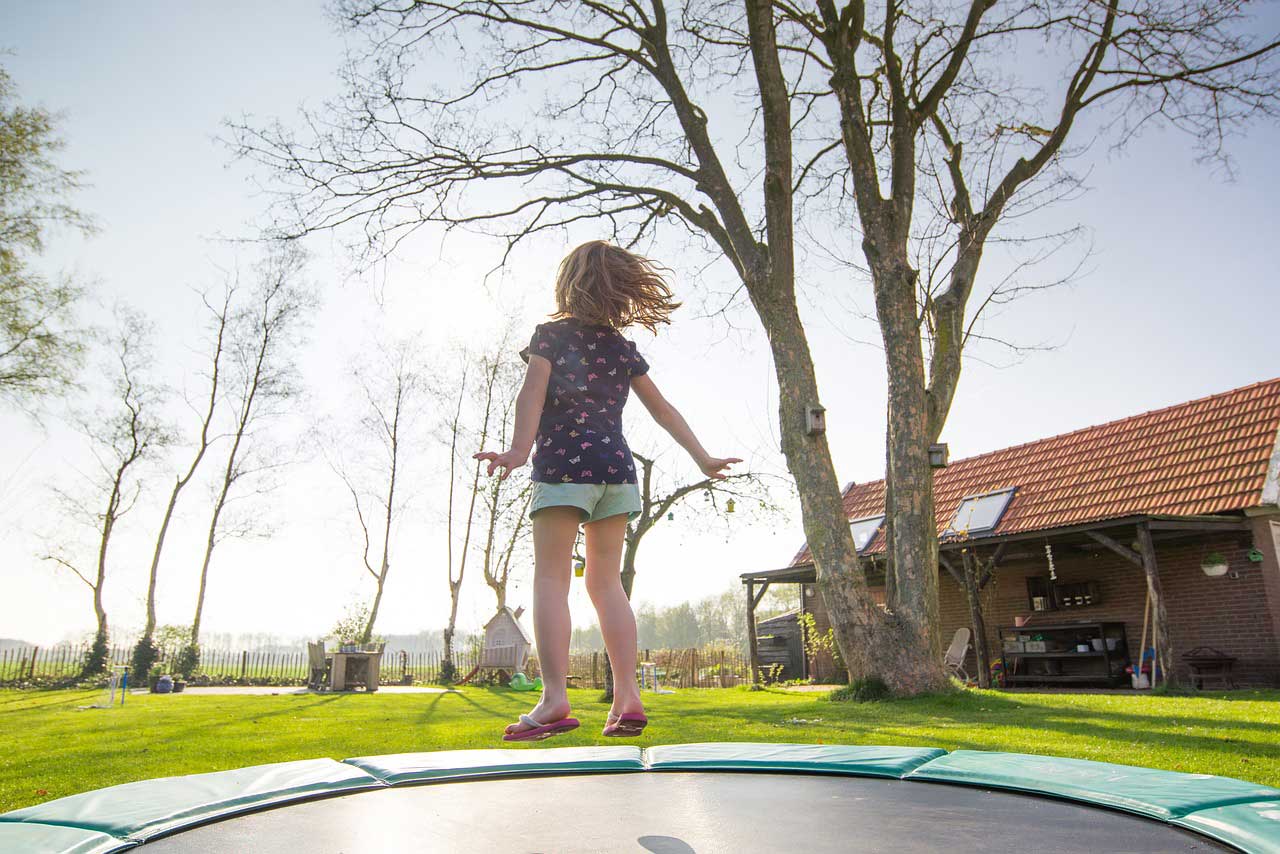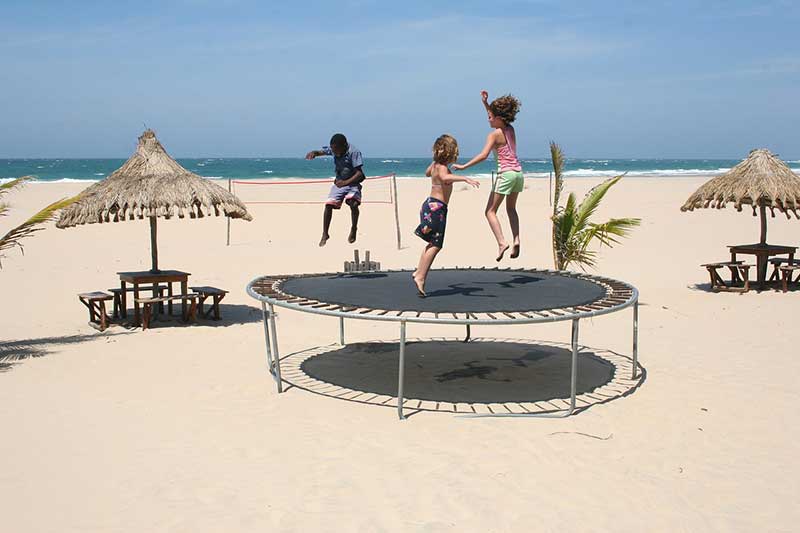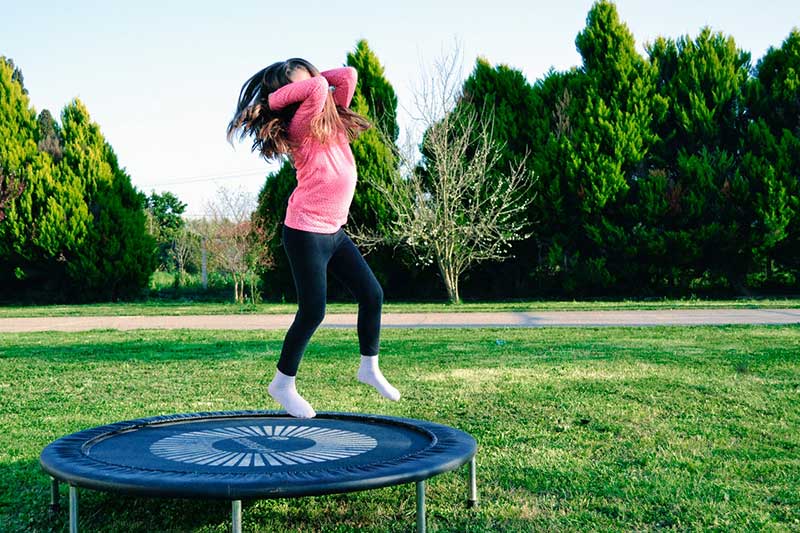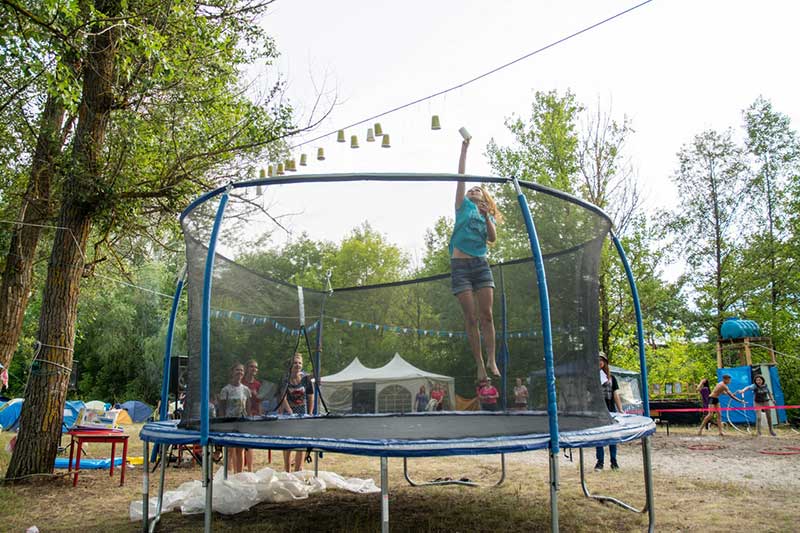
Image via Pixabay
It’s a given that trampolines are FUN. Because of this, they have become a fixture in most homes, entertaining kids and adults alike. In some instances, even pets! While jumping around a trampoline can be an exhilarating experience, you’ve probably asked yourself, how much weight can a trampoline hold?
Knowing the weight limit of your trampoline is VERY important because of obvious safety reasons. We’re here to discuss the matter of how much weight can a trampoline hold in full detail.
How Much Weight Can A Trampoline Hold, Really?

Image via Pixabay
The manufacturer usually indicates the weight limit of a trampoline when you purchase it. However, knowing is half the battle. There are other factors you need to consider. Pushing the weight limit might compromise your family’s safety, so it’s best to know the best and most ideal conditions when using a trampoline.
Keep in mind, that you don’t use a trampoline like a bed; you jump on it, and it makes you bounce high in the air. Weight limits are provided, not just for safety but for operational purposes as well. The bouncing motion is what makes jumping on a trampoline worth your while. Weight plays a crucial factor in the scheme of things because a trampoline has to be able to match the downward force with the upward force, with springs fulfilling this function.
Why Is It Important To Know The Weight Limit Of A Trampoline?
Besides springs, the materials used for a trampoline also play a significant role in determining the weight limit because they are also responsible for creating that bouncing motion. Lightweight trampolines are ideal for kids while heavyweight ones are built for adults.
Why is this information necessary? Because heavyweight trampolines are made with high-density spring material compared to lightweight ones. Weight has got a lot to do with creating the upward and downward forces which make us bounce.
To demonstrate, a lightweight person jumping on a heavyweight trampoline won’t be able to generate the downward force needed to create the equivalent upward force.
Conversely, a heavyweight person who uses a lightweight trampoline will generate a downward force that exceeds the capabilities of the springs to create the equivalent upward force. Plus, there is also the possibility of breaking the springs (and possibly tearing the jumping pad) in the process.
How much weight can a trampoline hold? It all depends on the type of trampoline you’re going to purchase. In order to make a sound decision on which trampoline to acquire, it is important to make an accurate evaluation of who will be using the trampoline and what weight range you should be working with.
How Is The Weight Limit Of A Trampoline Determined?

Image via Pexels
There are several factors which determine the weight limit of a trampoline. How much weight can a trampoline hold in terms of:
Materials
A trampoline is constructed using these three important components:
- Springs
- Jumping pad
- Frame
1. Springs
The springs are responsible for producing the bouncing motion. They are the foremost basis in determining a trampoline’s weight limit.
2. Jumping pad
The jumping pad is usually made of woven polypropylene or waterproof canvas. Determining the weight limit depends on the type of material used for the jumping pad and how the material is woven (i.e. lightweight jumping pads usually have fewer stitching rows as compared to heavyweight ones).
3. Frame
The frame plays a vital role when it comes to the structural integrity of a trampoline. Heavyweight trampolines have thick gauge steel frames for better stability, as compared to lightweight trampolines.
Size
As a general rule, the smaller the trampoline, the lower the weight limit will be. Trampolines come in various sizes and their corresponding weight limits.
A toddler trampoline typically measures around 8 to 10 feet and weighs about a hundred pounds. The weight limit for a toddler trampoline is between 75 to 150 pounds. Because of this weight limit, the toddler trampoline is recommended to be used ONLY by children ages 3-10 years old (note that children aged 5 and under are not allowed on the trampoline). The toddler trampoline is ideal for this age group because they are lower and come with safety handrails. A toddler trampoline will fit in a small backyard.
To enumerate further on the weight limits of other trampoline sizes: a 12-foot trampoline can bear around 250 to 300 pounds; a 14-foot trampoline holds between 250 to 350 pounds; and a 15- to 16-foot trampoline holds between 250 to 450 pounds. Because of their hefty weight limits, these trampolines are recommended for adults.
Style or Design

Image via Pexels
Trampolines are commonly sold in rectangular or round shapes. The design and shape of a trampoline also have a lot to do with determining the weight limit.
Rectangular trampolines can bear a heavier load as compared to their round counterparts because the way it’s designed puts lesser stress on the springs. Rectangular trampolines measuring 6 by 12 feet can hold up to 450 pounds, while rounded ones measuring 14 feet have a weight limit of about 400 pounds.
The springs of a rectangular trampoline are distributed in such a way that they work independently instead of simultaneously, depending on which part of the trampoline is being used. Because of this, rectangular trampolines are usually designed to withstand a gymnast’s stunts and movements.
What Happens When You Don’t Follow The Recommended Weight Limit?
There’s a reason why manufacturers indicate their recommendations — to ensure user safety. Not following these precautions can compromise the structural integrity of your trampoline and worse, may lead to serious injuries. How much weight can a trampoline hold? Follow the manufacturer’s recommended weight limit and strictly adhere to it is the ONLY answer.
Are There Other Important Safety Measures Besides Knowing The Weight Limit?
Image via Pixabay
Just like any other toy or gadget, a trampoline comes with manufacturer warnings and precautionary measures that you need to take note of, before and during installation, and while using the trampoline. Some of these safety precautions include the following:
1. Check your trampoline for any signs of damage or structural issues during assembly.
2. Make sure that the trampoline springs are installed tightly and properly. The springs can become corroded and stretched over time, make sure to replace them when that happens.
3. Install the trampoline on a flat, even ground (preferably with a soft surface such as grass, sand, etc.) Avoid setting the trampoline on hard surfaces such as concrete or asphalt, unless you have a trampoline safety net or a crash mat installed with it.
4. Place the trampoline within a safe distance from trees, walls, fences, or any other structure that may cause injury. Providing a safe and clear fall zone of at least 8 feet around the outside of the trampoline is a must.
5. Cover the springs, hooks, and frame with shock-absorbing safety pads before using.
6. Ensure that the trampoline has an enclosure. 70 percent of trampoline-related injuries are caused by the lack of a safety enclosure.
7. Train your kids to use the trampoline ladder when getting on and off the trampoline. NEVER let them jump in and out of the trampoline to avoid injuries.
8. Wear proper clothing before using the trampoline. Avoid clothes with drawstrings to prevent injuries.
9. Remove all jewelry and other sharp objects from your pockets before using the trampoline.
10. Remove objects under the trampoline before using.
11. Keep children under close adult supervision whenever they use the trampoline to prevent injuries. Children aged 5 and under should not be allowed on a trampoline.
12. Do not allow more than one person to jump at one time.

Image via Pixabay
13. Do not allow children to do somersaults, backflips, or stunts on the trampoline.
14. Do not allow children to use the trampoline when it’s wet.
15. As a general rule, pets should not be allowed on the trampoline. In the event that your pet uses it, keep your children away from the trampoline to avoid accidents.
16. For adults, do not use the trampoline when under the influence of drugs or alcohol.
Conclusion
Although purchasing a trampoline can be entertaining, it also comes with great responsibility. Because using a trampoline may cause accidents or potential injuries, it would be best to purchase a reliable and reputable brand because they provide more accurate weight limits compared to cheaper brands.
If you’re thinking of using a trampoline mostly for fun and leisurely purposes, purchasing a round trampoline instead of a rectangular one is highly recommended. Rectangular trampolines provide a higher bounce and can be more dangerous than round ones.
Knowing how much weight can a trampoline hold is just one of many other details that you need to be aware of before purchasing and installing one in your backyard.
We hope we provided you with comprehensive information and sound advice that go beyond answering the question, how much weight can a trampoline hold?
A trampoline can be a fun addition to your home; all that jumping and bouncing is actually good exercise! But remember, safety should always come first.

Leave a Reply